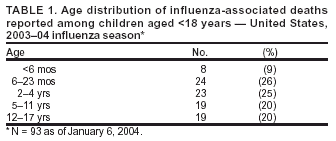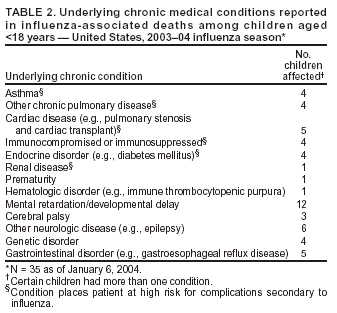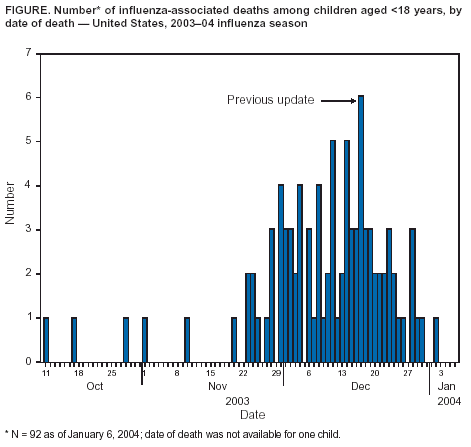 |
|
|
|
|
|
|
| ||||||||||
|
|
|
|
|
|
|
||||
| ||||||||||
|
|
|
|
|
Persons using assistive technology might not be able to fully access information in this file. For assistance, please send e-mail to: mmwrq@cdc.gov. Type 508 Accommodation and the title of the report in the subject line of e-mail. Update: Influenza-Associated Deaths Reported Among Children Aged <18 Years --- United States, 2003--04 Influenza SeasonDuring the 2003--04 influenza season, CDC has received reports from state health departments regarding deaths among children with evidence of influenza virus infection. To help investigate these deaths, CDC has requested that all influenza-associated deaths among children aged <18 years be reported to CDC through state and local health departments during the 2003--04 season. This summary is based on preliminary data reported from 31 states as of January 6, 2004, and updates a previous report published in MMWR (1). Since October 2003, a total of 93 influenza-associated deaths among children aged <18 years have been reported to CDC. All patients had evidence of influenza virus infection detected by rapid antigen testing or other laboratory tests. The date of death was reported for 92 of the 93 cases (Figure). The median age of the 93 children was 4 years (range: 4 weeks--17 years), with 55 (59%) children aged <5 years and 24 (26%) aged 6--23 months (Table 1). Among the 92 children whose sex was reported, 41 (45%) were male. A total of 35 (38%) of the 93 children were reported to have had underlying chronic medical conditions (Table 2), and 41 (44%) were reported to have had no underlying conditions; the medical history was unknown for 17 (18%) children. Of the 55 children for whom the location of death was reported, 15 (27%) died at home, 12 (22%) died in emergency departments, 25 (45%) died as inpatients, and three (5%) died in transport to hospitals. Pneumonia was a reported complication in 25 of the 93 children. Invasive bacterial co-infections were reported in 15 children, including methicillin-resistant Staphylococcus aureus, Streptococcus pneumoniae, Streptococcus pyogenes, Enterococcus sp., Haemophilus influenzae (type b and non-typable), Neisseria meningitidis, Escherichia coli, Pseudomonas aeruginosa, Klebsiella pneumoniae, and Serratia marcescens. Of the 45 children whose influenza vaccination status was reported, one child had evidence of adequate vaccination, whereas 33 (73%) were not vaccinated, and six children were partially vaccinated (i.e., they had received 1 of 2 doses); five children were reported as vaccinated, but the interval between vaccination and onset of illness was not documented. Influenza A viruses were isolated from respiratory specimens collected from 28 patients. A total of 55 children had influenza virus infection confirmed by rapid antigen testing and direct fluorescent antibody staining of respiratory specimens. Four additional children had influenza virus infection confirmed solely by reverse transcriptase polymerase chain reaction (RT-PCR) of respiratory specimens. A total of 16 children with evidence of influenza virus infection by culture, rapid antigen detection test, or RT-PCR also had autopsy specimens tested at CDC by immunohistochemical (IHC) staining. Of these, 11 had influenza A viral antigen detected by IHC staining in respiratory epithelium of airway tissue specimens (2). In addition, autopsy tissue specimens from four of 11 pediatric deaths without previous laboratory confirmation of influenza virus infection were positive by IHC staining for influenza A viral antigen. Reported by: State and local health depts. Influenza Response Team; I Shui, MPH, Assoc of Schools of Public Health/CDC/ATSDR Internship Program; N Bhat, MD, M Glover, ScD, K Broder, MD, D Posey, MD, EIS officers, CDC. Editorial Note:During October 11, 2003--January 6, 2004, a total of 93 influenza-associated deaths among children aged <18 years were reported to CDC. Of the 51 deaths that were not reported previously, 26 occurred before publication of the previous report (1). Because laboratory-confirmed influenza illnesses and deaths among children are not nationally reportable conditions, the numbers of deaths reported this season cannot be compared directly with previous influenza seasons, and the proportion of illnesses associated with death cannot be estimated. Heightened awareness of severe complications and deaths associated with influenza among children this season and increased testing might be contributing to identification of more pediatric fatalities related to influenza than in previous seasons. These reports underscore the need to further characterize the impact of influenza among children. In addition to initiating voluntary reporting of influenza-associated deaths, CDC is developing studies in collaboration with health departments and other partners to estimate the rates of influenza-associated hospitalization and serious complications and to identify risk factors for severe illness and complications during the current season. Additional studies are planned to assess the relative severity of this season by comparing influenza-associated hospitalizations and mortality among children with those in previous seasons. Such information might be helpful in evaluating current pediatric influenza vaccination recommendations. Clinicians should consider influenza testing in children who have severe febrile illness, when influenza viruses are circulating in their local community. Clinicians should recognize that secondary conditions such as bacterial infection can complicate some cases of influenza. Susceptibility testing of bacterial isolates is important to guide appropriate antibiotic therapy. Guidelines for antiviral treatment of influenza have been published (3). CDC Request for Reports of Influenza-Associated Deaths Among ChildrenDuring the 2003--04 influenza season, CDC is requesting that all influenza-associated deaths among children aged <18 years be reported to CDC through state and local health departments. In addition, CDC is requesting submission of postmortem tissue specimens and autopsy reports when available. Influenza viral isolates in fatal cases also should be sent to CDC for antigenic characterization. To report the influenza-associated death of a child aged <18 years, state and local health departments should contact CDC's Influenza Branch, telephone, 800-232-4636; e-mail, eocinfluenza@cdc.gov. Case reporting forms are available to state and local health departments and medical examiners via the Epidemic Information Exchange (Epi-X), accessible at http://www.cdc.gov/mmwr/epix/epix.html. Completed forms should be sent to CDC with a cover sheet with the heading, "ATTN: Fatal Case Reporting" via fax, 888-232-1322. References
Table 1  Return to top. Table 2  Return to top. Figure  Return to top.
Disclaimer All MMWR HTML versions of articles are electronic conversions from ASCII text into HTML. This conversion may have resulted in character translation or format errors in the HTML version. Users should not rely on this HTML document, but are referred to the electronic PDF version and/or the original MMWR paper copy for the official text, figures, and tables. An original paper copy of this issue can be obtained from the Superintendent of Documents, U.S. Government Printing Office (GPO), Washington, DC 20402-9371; telephone: (202) 512-1800. Contact GPO for current prices. **Questions or messages regarding errors in formatting should be addressed to mmwrq@cdc.gov.Page converted: 1/8/2004 |
|||||||||
This page last reviewed 1/8/2004
|